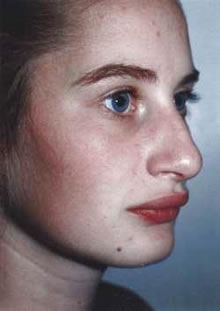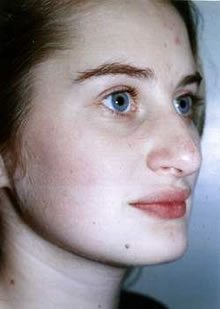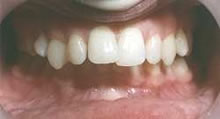Advantages. Will reliably achieve good alignment of the teeth within 18 to 24 months. Widely available. Registered orthodontists are University trained. Treatment can be delayed until twelve or fourteen.
Disadvantages. They nearly always involve extractions either before or after treatment. They usually retract the upper jaw to match the lower and this tends to increase the vertical growth of the face. This may be barley noticeable but is if the face is already too long the damage may be severe. The teeth often to re-crowd in the years following treatment unless they are held straight indefinitely. The ‘train tracks’ cause damage to the roots and enamel of the teeth but these are usually considered acceptable. Some clinicians believe that patients are subsequently liable to headaches and joint damage but there is conflicting evidence about this.
Advantages. Brings the lower jaw forward and widens the upper jaw. Reduces the number of extractions. Causes less damage to the teeth. Treatment can be started earlier if required.
Disadvantages. Usually requires ‘train tracks’ to gain the final alignment but causes less damage to the teeth and face provided the treatment is started early. Requires a longer period of day and night treatment. Takes back the upper jaw slightly, and lengthens the face especially if crowding is severe. Teeth often require holding straight afterwards.
Advantages. Takes both jaws forward. This should produce an improvement in facial appearance. ‘Train tracks’ and extractions only required in severe cases started late. Short treatment period in mild cases. Shorter period of day time wear for most cases. Almost no damage to the teeth. Teeth do not need holding straight after the patient has corrected their mouth posture. The facial improvements achieved by Orthotropics have not been matched by any other technique.
Disadvantages. More difficult for the operator. The teeth are not as perfectly aligned at the end of treatment but usually improve subsequently (the reverse of ‘train tracks). Treatment best started before eight (earlier in severe cases). Requires high levels of co-operation from the patient who must wear inconvenient appliances for long periods and learn to keep their mouth closed and swallow correctly. If patient can not achieve this, night time wear may last several years. However it is a ‘fail safe’ option and even a slight improvement of mouth posture is likely to provide a better long-term result than ‘Train tracks’.
Can it avoid the need for surgery? Yes often. Patients who have already been told that they will have to have their jaws cut, have a strong incentive to co-operate and the success rate of ‘Orthotropics®’ in these circumstances, is good even if some of them are considerably older. However they are treated, it is still important that patients are able to correct their mouth posture, and failing this many will relapse.




Age seventeen and a half and nine months later, she was treated with orthotropics.
She had been told that cutting her jaws was the only possible treatment.
Even with conventional surgical cases it is still important that the patients are able to correct their mouth posture, and failing this about 30% will suffer the same long term relapse.